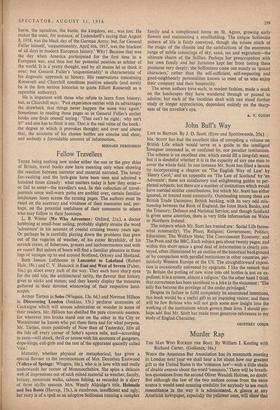Fellow Travellers
THERE being nothing new under either the sun or the grey skies of Britain, travel books now have meaning only when showing the reaction between narrator and material narrated. The lovely fan-vaulting and the lych-gate have been seen and admired a hundred times already: what matters today is how they enter— or fail to enter-the traveller's soul. In this collection of travel- journals some well-worn paths are ambled over, certain familiar landscapes loom across the turning pages. The authors must be rated on the accuracy and vividness of their memories and, per- haps, on the potential usefulness, of their comments to others who may follow in their footsteps.
L. B. Winter (We Who Adventure: Oxford, 21s.), a doctor hobbying at small-boat sailing, probably slightly strains the word 'adventure' in his account of coastal cruising twenty years ago. Or perhaps he is carefully playing down the problems that grew out of the vagaries of weather, of his cutter Brynhildr, of his scratch crews, of fishermen, grocers and harbourmasters met with en route? But sailors of boats will find a familiar pleasure in these logs of voyages up to and around Scotland, Orkney and Shetland.
Both Jessica Lofthouse in Lancaster to Lakeland (Robert Hale, 18s.) and C. V. Hancock in East and West of Severn (Faber, 16s.) go afoot every inch of the way. They each have sharp eyes for the odd tale, the architectural rarity, the flavour that history. gives to sticks and stones; and they keenly display the treasures gathered in their devoted winnowing of their respective land- scapes.
Arthur Tietjen in Soho (Wingate, 13s. 6d.) and Norman Hillson in Discovering London (Jenkins, 15s.) perform anatomies of Cockaigne which will arouse admiration or wonder in some of their readers. Mr. Hillson has distilled the pure ciceronic essence, for wherever two bricks stand one on the other in the City or Westminster he knows who put them there and for what purpose. Mr. Tietjen, more positively of Now than of Yesterday, lifts all the lids off every corner of Soho's square mile, and—according to taste—will shock, thrill or amuse with his accounts of gangsters, dope-kings, call-girls and the rest of the apparatus quaintly called 'vice.'
Maturity, whether physical or metaphorical, has given a special flavour to the reminiscences of Mrs. Dorothea Eastwood (Valleys of Springs : Wingate, 18s.), who is in love with and really understands her corner of Monmouthshire. She spins a delicate web of impressions out of such mixed material as weather, family, botany, mountain walks, salmon fishing, as recorded in a diary of three idyllic seasons. Mrs. Wendy Aldridge's title, Hobnails and Sea Boots (Harrap, 15s.), is cumbrous, insufficient and ugly; her story is of a spell as an adoptive Scillonian running a complek family and a complicated home on St. Agnes, growing early flowers and maintaining a smallholding. The unique Scillonian pattern of life is fairly conveyed, though she misses much of the magic of the climate and the satisfactions of the enormous range of subtle colourings of sky, sand, sea and vegetation—the ultimate charm of the Scillies. Perhaps her preoccupation with her own family and her furniture kept her from tasting these pleasures very deeply; the Scillonians come out mostly as 'quaint characters,' rather than the self-sufficient, self-respecting and good-neighbourly personalities known to most of us who enjoy their company and their hospitality.
The seven authors have each, in modest fashion, made a mark on the landscapes they have wandered through or paused to admire; but each of the localities dealt with can stand further study or longer appreciation, dependent entirely on the sharp- ness of the traveller's eye.


































 Previous page
Previous page